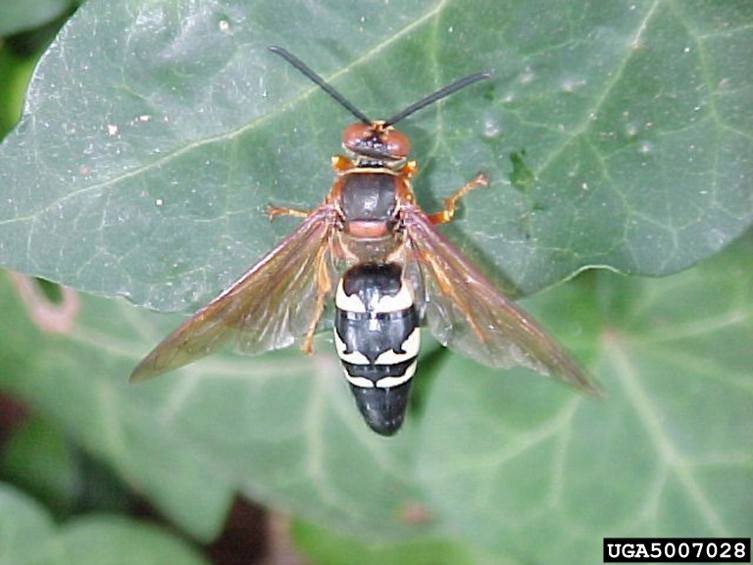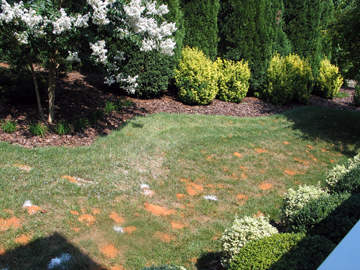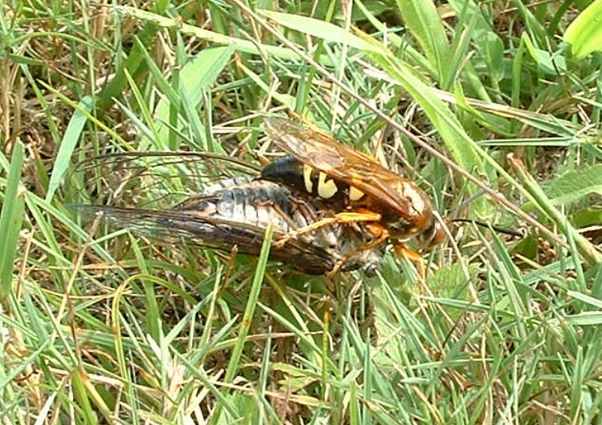 You are out and about in your South Jersey yard and you see this huge “bee” hovering around your bushes. It’s about 2 inches long and your first instinct is to be frightened of it getting anywhere near you.
You are out and about in your South Jersey yard and you see this huge “bee” hovering around your bushes. It’s about 2 inches long and your first instinct is to be frightened of it getting anywhere near you.
Image courtesy of Nancy Hinkle, University of Georgia, Bugwood.org
This menacing looking creature is not a “bee” it is a digger wasp called a Cicada Killer and it is NOT interested in you!
Adults Cicada Killers emerge in summer, around late June or early July and die off in September or October.
If it’s a female Cicada Killer, you will see it floating around your lawn for a good place (think sandy, bare, well-drained soil exposed to full sunlight) to dig burrows to lay their eggs and searching for cicadas in trees and shrubs to feed them.
Females are not aggressive and rarely sting unless they are grasped roughly, stepped upon with bare feet, or caught in clothing, etc.
If it is a male Cicada Killer, they only aggressively defend their territory on nesting sites against other male rivals, and cannot sting. Although they appear to attack anything that moves near them, male Cicada Killers are actually looking for a female Cicada Killer ready to mate.
 If handled roughly, females will sting, and males will jab with a sharp spine on the tip of their abdomen. Both sexes are well equipped to bite, as they have large jaws.
If handled roughly, females will sting, and males will jab with a sharp spine on the tip of their abdomen. Both sexes are well equipped to bite, as they have large jaws.
Image courtesy of Dawn Dailey O’Brien, Cornell University, Bugwood.org
They are generally non-aggressive towards humans and usually fly away when swatted at, instead of attacking.
If you are allergic to bee stings, get immediate medical assistance if you are stung.
 If you have reddish brown patches in your lawn they are probably Cicada Killer burrows. Since colonies of burrows are common, infested lawns usually contain several mounds that can smother the grass.
If you have reddish brown patches in your lawn they are probably Cicada Killer burrows. Since colonies of burrows are common, infested lawns usually contain several mounds that can smother the grass.
Female Cicada Killers also like to burrow next to raised sidewalks, driveways and patio slabs. They may also nest in planters, window boxes, and flower beds or under shrubs and ground cover.
 After digging a nest chamber in the burrow, female Cicada Killers use their sting to paralyze their prey – Cicadas – (pictured on the left) rather than to defend their nests.
After digging a nest chamber in the burrow, female Cicada Killers use their sting to paralyze their prey – Cicadas – (pictured on the left) rather than to defend their nests.
 Image courtesy of Kenneth R. Law, USDA APHIS PPQ, Bugwood.org
Image courtesy of Kenneth R. Law, USDA APHIS PPQ, Bugwood.org
After paralyzing a cicada, the female wasp holds it upside down beneath her and takes off toward her burrow; this return flight to the burrow is difficult for the wasp because the cicada is often more than twice her weight.
In a typical season, 100 female Cicada Killers will clear over 16,000 cicadas from the surrounding area which is good news for your oak, maple, and birch trees.
What you can do if you already have a Cicada Killer problem:
- The most economical control is to take a whack at them with a racket or Frisbee.
- Try keeping the areas where they dig nests much wetter than usual – fill the burrows with water and wash away the piles of dirt surrounding them.
- Be patient for 2 months, they will go away on their own.
What you can do to help prevent Cicada Killer nesting and ruining your lawn:
- Plant dense, tall vegetation.
- Lime, fertilize and frequently water your lawn.
- Mow your lawn on the highest setting during their nesting period (June-August).
- Make sure you have a three-inch layer of hardwood mulch in garden beds.
If you are tired of being frightened in your own backyard or if Cicada Killers are ruining your lawn – we can help to minimize the problem as quickly as possible – Call AB-Con today!
